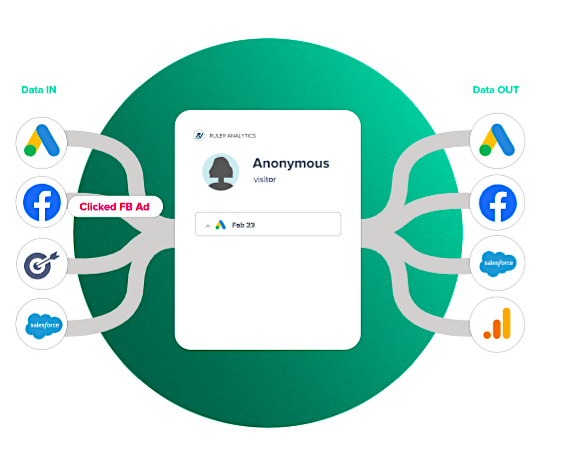You probably already have a list of about one hundred different content marketing metrics that you could use to track and measure the success of your content strategy. However, if you try tracking too many metrics, you’ll either:
- Feel overwhelmed and give up before you get started and ultimately track nothing
- Track all 100 metrics, but with so many different signals, you won’t take action on the data
Another issue with content marketing metrics is that setting up tracking can be very difficult (or even impossible) depending on the tools provided by your company and your own technical abilities.
So instead of writing a post that gives you hundreds of metrics to track, this post takes a look at the six most important content marketing metrics.
New to content strategies? Check out:
How to Create a High-Performance Content Marketing Strategy in 2023
The 6 Most Important Content Marketing Metrics
Let’s go through and examine each one.
1) Conversions
Tracking conversions is at the top of this list because the end goal of your content should always be to drive more business. While all the other metrics listed below are important, they ultimately exist to help you achieve conversions.
Put simply, conversions are your north star, and all the other metrics are paths leading to it:
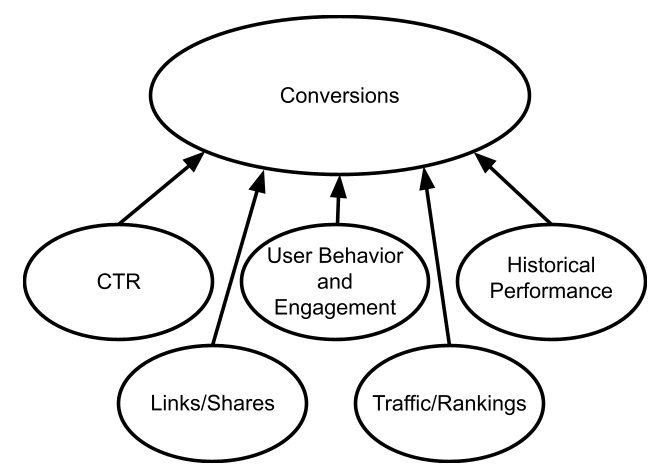
Unfortunately, most people tend to lose sight of conversions as a content marketing metric due to the complexity of the customer journey. For example, did a new customer convert from the email campaign and just coincidentally read a blog post? And was the blog post a critical element that pushed them to ultimately purchase the product?
For this reason, many companies, while they admit that their main content marketing goal is to drive conversions, don’t make any attempt to track conversions from content.
Even if it’s not a perfect metric, tracking conversions is still useful as you’ll soon see which pieces of content are ultimately tied to a sale. This way, you can ensure that the content team continues producing posts similar to those that often end in a conversion.
Another reason why many businesses don’t track conversions from content is that, until a few years ago, there wasn’t an easy way to track conversions from content. You can hire a developer to set up tracking in Google Analytics, but that doesn’t provide the full customer journey (only first touch and last touch data).
Now, however, companies like Oribi and Ruler Analytics exist and make it much easier to track the entire customer journey:
- You can identify which blog posts show up the most in customer journeys that end in a sale
- You can pinpoint precisely where the content showed up in the customer journey
- You can see how much time passed before the conversion happened
Tracking the entire customer journey is helpful because if a particular post tends to be consumed within a few days of the conversion, there’s a very good chance that the content directly caused the conversion.
While these tools aren’t cheap, they are super easy to set up and provide much more insight than older tools like Google Analytics.
Regardless of how you choose to track your conversions, setting up some kind of tracking will be useful as it can teach you what kind of content to create in the future to improve your bottom line.
Before you track conversions, make sure you optimize them:
15 Fast and Easy Ways to Improve Your Site’s Conversion Rate
Their expertise has helped Nextiva grow its brand and overall business
2) CTR (Click-Through Rate)
If people consistently click on your listing in the SERPs, Google will assume it is an excellent answer to the search term. Since every search engine’s goal is to provide the searcher with the best answer to their question, they will rank you higher.
Therefore, it’s important to optimize your title tag and meta description to be as appealing as possible without being misleading.
This template can help you with your title tags:
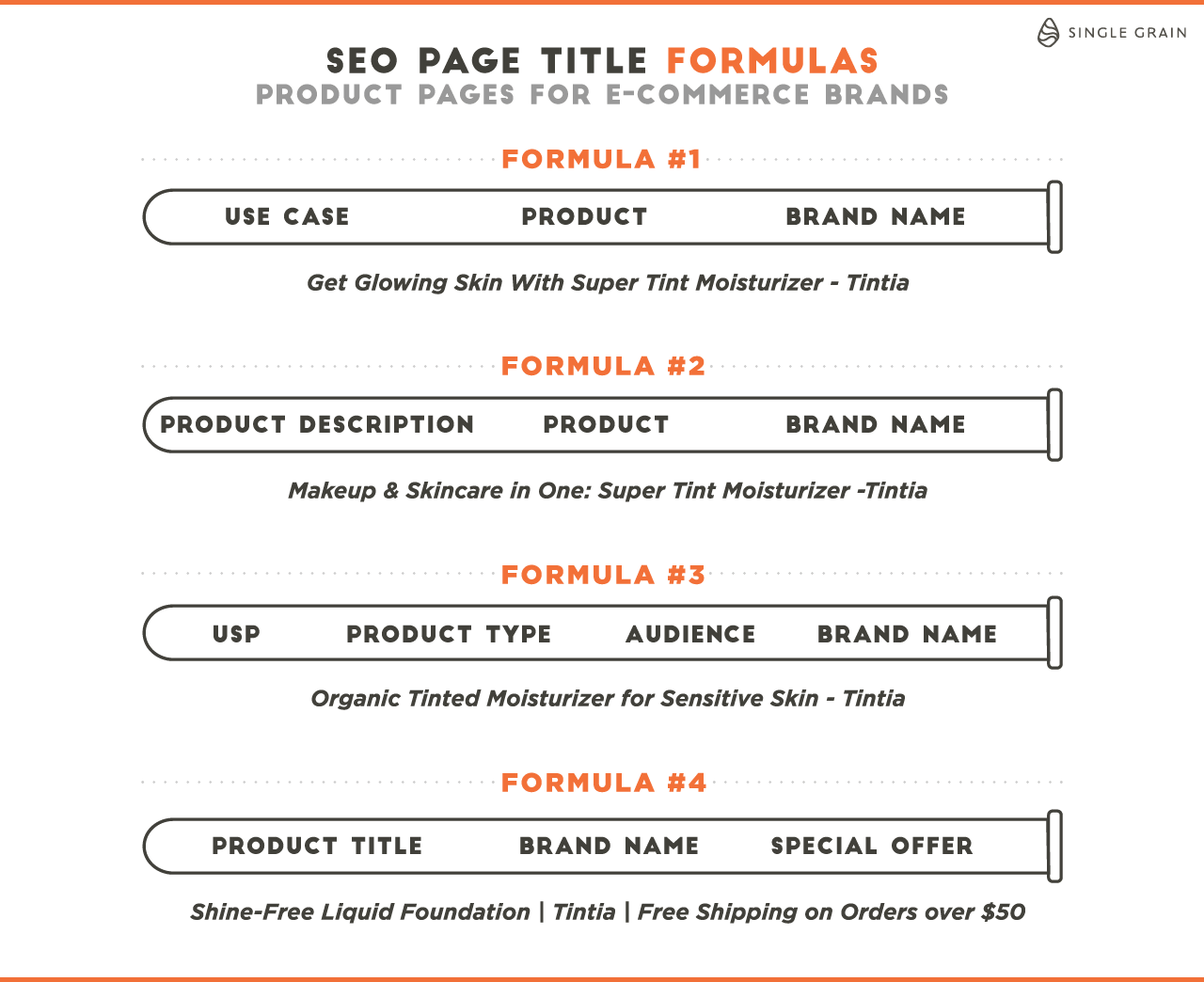
Here are a few tips to help you improve your CTR via the title tag and meta description:
- Include the current year in the title – this is particularly helpful for guides and list posts – but not in the URL
- Include the main keyword in the title tag and meta description
- Use structured data whenever possible
- Ensure that each title falls between 15 and 40 characters
- Add sentiment to your titles (either positive or negative)
While I could make an endless list about what you should and shouldn’t do to increase your CTR, the best framework I’ve found to help me write better title tags and meta descriptions is to take a second and think about the search intent behind the keyword. Specifically, I ask myself two questions:
- What is that searcher’s pain point?
- How can I communicate to them (through the title tag and meta description) that my content provides the solution to their pain point (i.e. answer to their question)?
Once you think through those two questions, creating an effective title and meta description is pretty straightforward.
However, just because you’ve picked a title that you think is great doesn’t always mean that it will perform well. Therefore, A/B test your title tag and meta description to reduce the guesswork and see which one performs the best.
You can use a content optimization tool, which allows you to test two different title tags/meta descriptions to see which one performs better. Here’s an example of a test we recently ran:
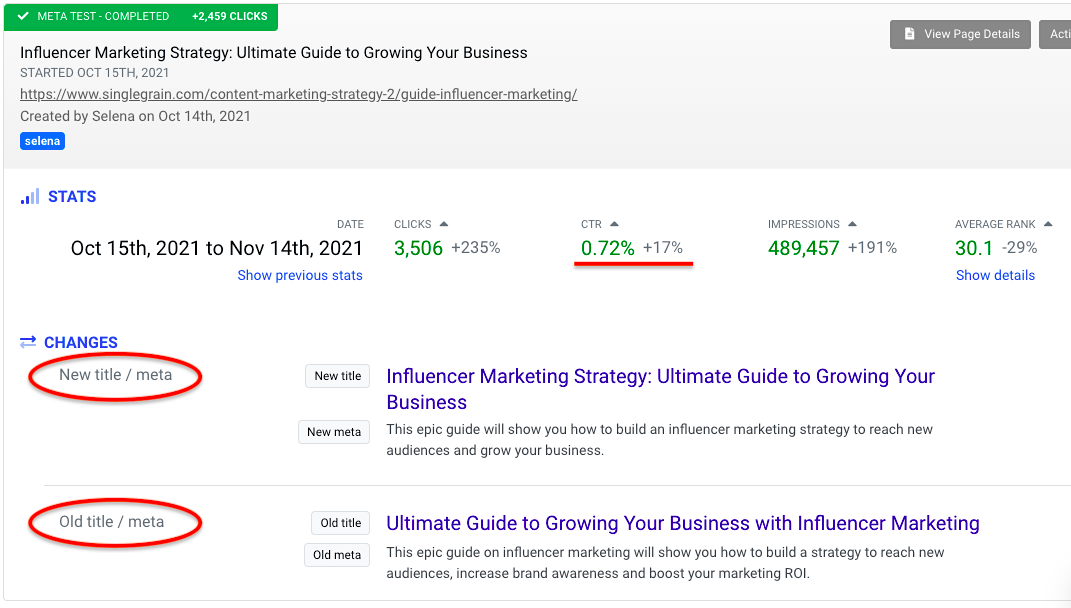
If you have hundreds of blog posts, it’s unrealistic that you’ll be able to test every single title and meta description. So how should you prioritize? To start improving your CTRs, you can either scroll through Google Search Console and manually identify these posts or use a tool, which will automatically show you a list of posts with high impressions yet low clicks.
In addition, keep an eye on your top-performing posts and continuously update those title tags/meta descriptions (even if the CTR is decent). This is because:
If you improve a post that’s pulling in 5,000 visitors per month by just 1%, you’ll see a much higher ROI than if you improve a mediocre post doing 100 visitors per month by 10%.
To identify your highest-performing posts, you can use a tool like Ahrefs to view the top-performing pages by traffic (Organic Search > Top Pages on the left side of the page) and manually keep an eye on those post’s CTRs (either in Google Search Console or in Click Flow):
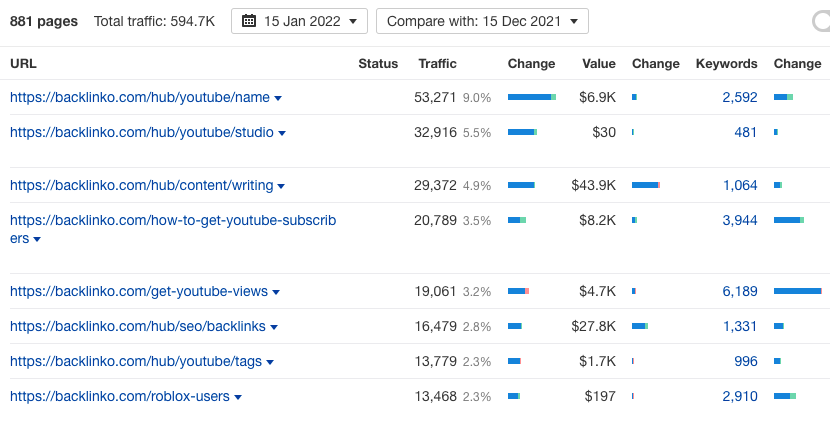
Improving your CTR is one of the most underrated content marketing tactics you can leverage, as it requires minimal effort yet has a significant impact on your content’s organic performance.
Need a refresher on improving CTRs? Read this:
11 Proven Hacks to Increase Your Organic CTRs 👆
3) User Behavior and Engagement
Google’s page experience update makes it more important than ever to track your user signals. While user experience conversations are often directed towards SEO folks, this topic is also essential for content marketers to consider.
So what kind of user behavior metrics should you track?
Time on page is perhaps the most important one. Though some search queries (such as “what’s today’s weather?” and “how many days are in February?”) don’t require a long time on page, guides, comparison posts and more detailed topics generally should.
To view the time on page for each blog post, just log into your Google Analytics account. From there, go to Behavior > Site Content > All Pages to see the average time on page for each post:

So how can you improve your time on page and overall reader engagement?
Here are a few ideas:
- Use beautiful graphics, short paragraphs, and clear subheadings (think Backlinko-style posts).
- Ensure that your font is large enough that it can be read from about 4-6 feet away.
- Improve the page load speed (you can use a tool like Pagespeed Insights to test the page speed).
- Review your copy to see where readers typically stop reading (use a heat map tool like Hotjar for this).
Finally, the best way to improve your user experience is to ask readers what they think of your content. Hotjar offers a question box feature, or you can use a tool like Qualaroo:
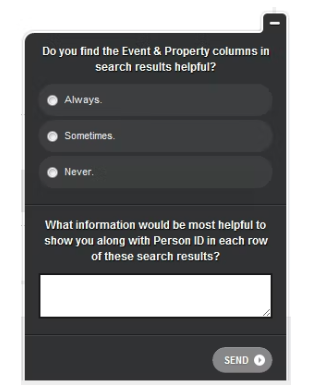
4) Historical Performance
While this may not be a widely accepted “metric,” tracking which posts have lost the most traffic over time is an excellent way to maximize traffic with minimal resources and effort.
Why? Rather than creating an entirely new piece of content (that search engines may or may not rank)…
Updating existing content that previously performed well requires minimal additional resources.
For example, we updated about 50 pieces of content that had once performed well and were now losing traffic. At the time of the update, the fifty posts were collectively pulling in about 9,000 visitors per month. We tracked each post several months after being updated, and the total traffic generated from them doubled to 18,000.
Therefore, rather than gambling on a new blog post that might not do well, consider updating your content.
After we identified which posts lost the most traffic we used Content Editor, another content optimization feature, to determine how to improve the older posts, such as keyword suggestions, word count targets, and more.
So once you know which posts to update, how should you actually update them?
Here is a brief overview of the key things to do when in order to refresh your content:
- Ensure that the blog post matches the search intent (for example, does the reader want a list post or a guide?). You can read more about search intent optimization here.
- Check for any unnecessary or outdated sections in your post that can be omitted.
- Verify that the post provides sufficient recent examples of the concepts introduced, as well as actionable steps to execute the advice given (including mentioning any tools, people you should hire, etc.).
- Make sure it doesn’t brush over or entirely omit any key concepts.
- Check that the design/format/style of the post is crisp and clean.
If you’re still stuck, you can also analyze the top-ranking posts in the SERPs and ask yourself what Google likes about them and why they might rank better than your posts.
Dive deeper into how content decay affects SEO:
What Is Content Decay and How It Affects Your SEO
5) Shares and Links
There’s been a lot of debate in the SEO community about how relevant shares and links will be in the future. However, it is true that Google’s original intention when making backlinks a ranking factor is that it’s a good measure of how much people like a certain blog post.
Therefore, you should also use shares and links as a metric to measure your content’s success. For example, data research, case studies, and original thought leadership posts naturally generate backlinks.
So even if a piece of content isn’t producing immediate conversions, it can still be helpful if it generates industry awareness and establishes your brand as an authority in the space. As your brand becomes well known throughout the industry, you’ll also generate more word-of-mouth referrals.
To measure your shares and links, you can once again use a tool like Ahrefs and sort via “Best By Links” or “Top Content” (under the “Pages” tab in the left-hand column):
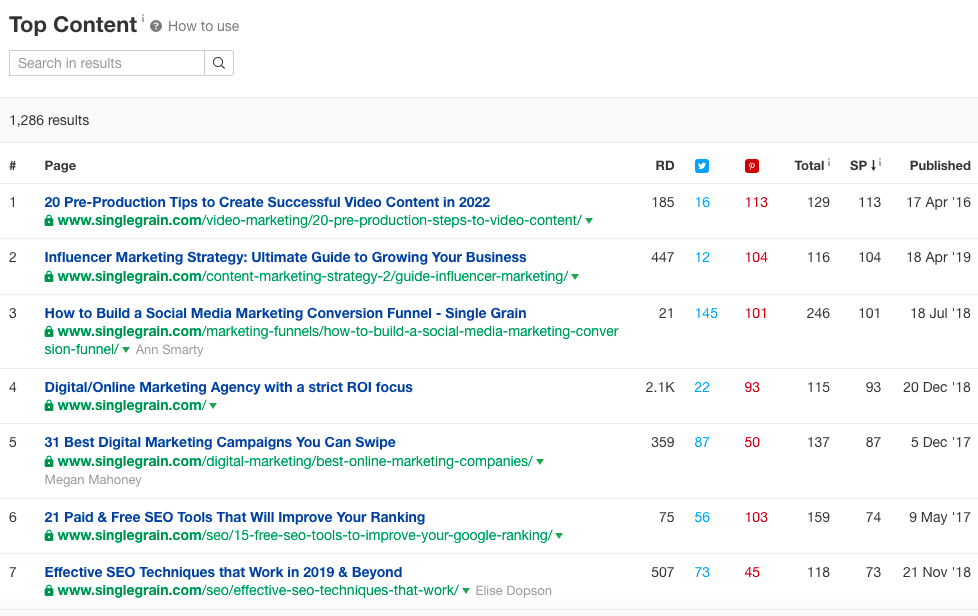
Now you can see which types of posts drive the most social engagement and which ones drive the most backlinks. With this information, you can look for patterns and double down on what’s working.
If you want to establish yourself as an industry leader and create better content that naturally earns more links/shares, here are a few ideas to help you achieve your goal.
A) Create an Original Data Study and Share It Around the Industry
A great example of this is when Brian Dean from Backlinko analyzed over 5 million search results to generate CTR data. He collaborated with us to perform original research. That post is currently the fourth highest link-generating post on his website:
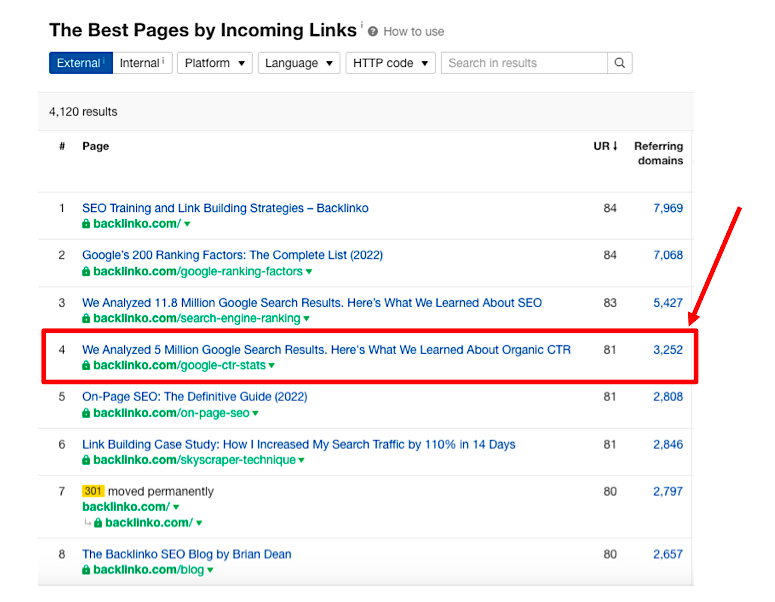
It has also generated links from some of the very best blogs in the SEO industry (such as Neil Patel, Ahrefs, Search Engine Journal) and the wider business community.
Look at all these dofollow links:
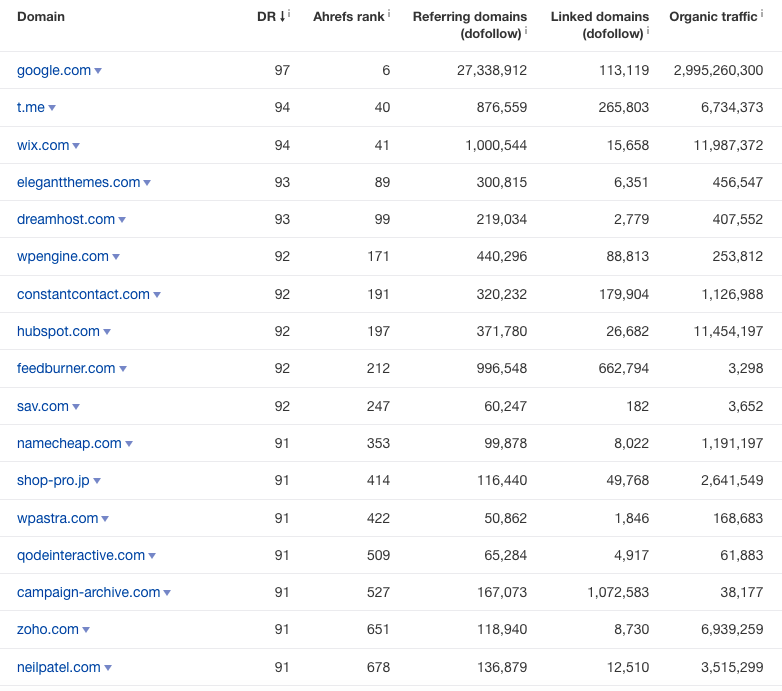
If I were to replicate something like this, I would either use my own data or partner with a company that has the data and then hire a data scientist on Upwork to mine the data.
You can also create smaller case studies, like the one we did that analyzes 50 of our agency’s blog posts.
As you choose the statistics you want to gather, come up with groundbreaking new ideas that will change how you do a certain process. For example, it’s not too hard to find statistics on things like the average word count of top-ranking pages. However, the data from Brian Dean’s CTR study wasn’t available anywhere else, and it uncovered patterns that changed how we write our blog post titles.
Finally, pitch the results to leading publications in your industry. You can ask a PR firm to help you with this if necessary, but you can also pitch guest posts yourself to support your link-building efforts.
For example, if I were Brian Dean, I might pitch Search Engine Journal, Content Marketing Institute, Ahrefs, and other leaders with a post that details how people can improve their CTRs. In that post, I would back up each piece of advice with stats from my original research. Ideally, the advice you’re giving is never-before-heard and therefore stands out.
Keep in mind that most people thought that using power words in the title tag could increase their CTR. Brian’s research proved this was actually false, and that power words decrease CTRs.
This is ultimately how you leverage original research to become a thought leader.
B) Create Original Stories/Case Studies (on Your Own Business or an Industry Leader’s Business
Another one of my favorite ways to generate a lot of links and social shares is to simply bring new ideas to the table through either your experiences or the experiences of an industry influencer.
Grow and Convert is a great example of using original stories to generate industry awareness. Nearly every post on their blog tears down how a process is typically done, dissects the problem with that traditional process, and then presents a new process to generate better results.
This post on their customer research process is an excellent example. You’ll see that it’s told as a story and doesn’t include any crazy results or statistics:
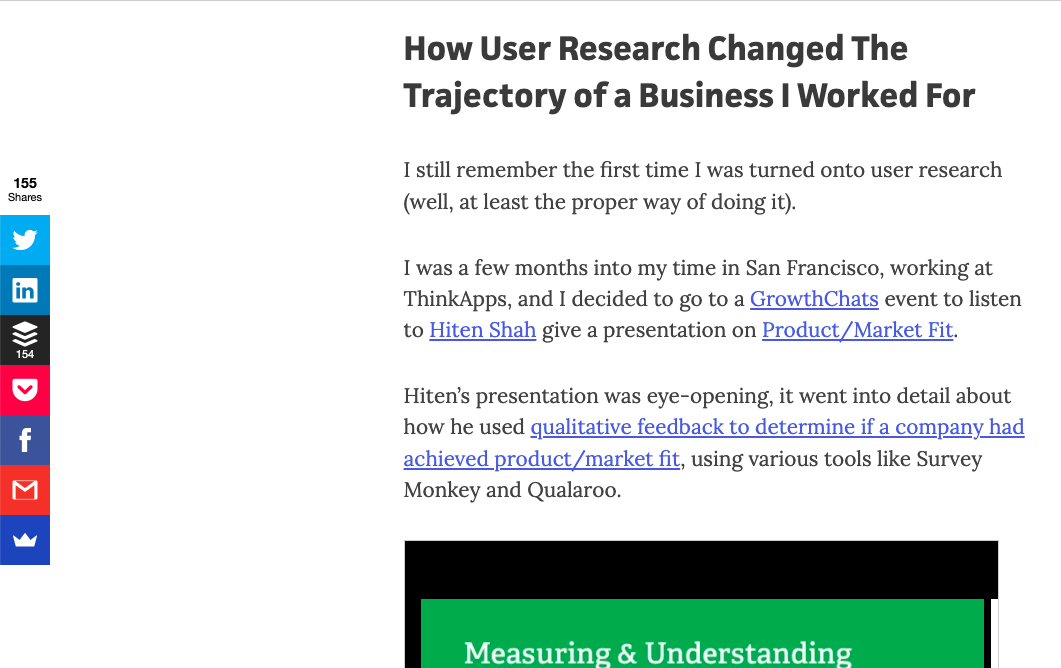
Rather, it challenges how a process is typically done, presents the solution, and shares some results.
You’ll also notice that it has 155 shares. Not too shabby for a blog post that probably took about one day to write.
I would also consider running paid ads or even guest posting on industry blogs and summarizing the idea to amplify that post’s impact. As long as it’s a new idea that most of the industry hasn’t heard of before, I find that most blogs are pretty receptive to guest posts.
Need to refresh your backlink knowledge? Check out:
The Skyscraper Technique: How to Build High-Quality Backlinks to Your Content
6) Traffic and Rankings
I purposefully put traffic and rankings last on this list as I find that they are sometimes overrated metrics. First and foremost, traffic and rankings don’t always correlate with more conversions. Nevertheless…
A site that generates a lot of the right traffic and ranks well for the right keywords is bound to perform very well.
Since we’ve already discussed how to make a post rank higher in the historical performance section, let’s now discuss how you know if you’re bringing in the right audience.
First, take a moment to write down:
- Who your audience is
- What pain point they have that your product solves
Let’s tackle these one at a time.
Learn More:
* SEO & CRO: How Rankings and Conversions Complement Each Other
* 14 Effective SEO Techniques to Drive Organic Traffic in 2023
A) Who Is Your Audience?
To ensure that your content attracts the right audience, you need to get really specific with who your audience is:
- Instead of just saying “my tool is for salespeople,” ask yourself if it is for sales managers or sales reps?
- Then dig deeper: Who feels the pain point, and who is actually purchasing the product?
For example, a sales rep may have issues finding prospects’ emails. So they may tell their sales manager that they want a new email finder tool. From there, the sales manager might do some research and then make the actual purchase.
So your audience would be:
- TOFU: You might want your top-of-funnel posts to discuss pain points felt by sales reps as they are the ones doing the original research.
- BOFU: However, as you move further down the funnel to posts like “Hunter.io alternatives,” you might want to discuss the pain points felt by sales managers, as they probably do some research before making the final purchase.
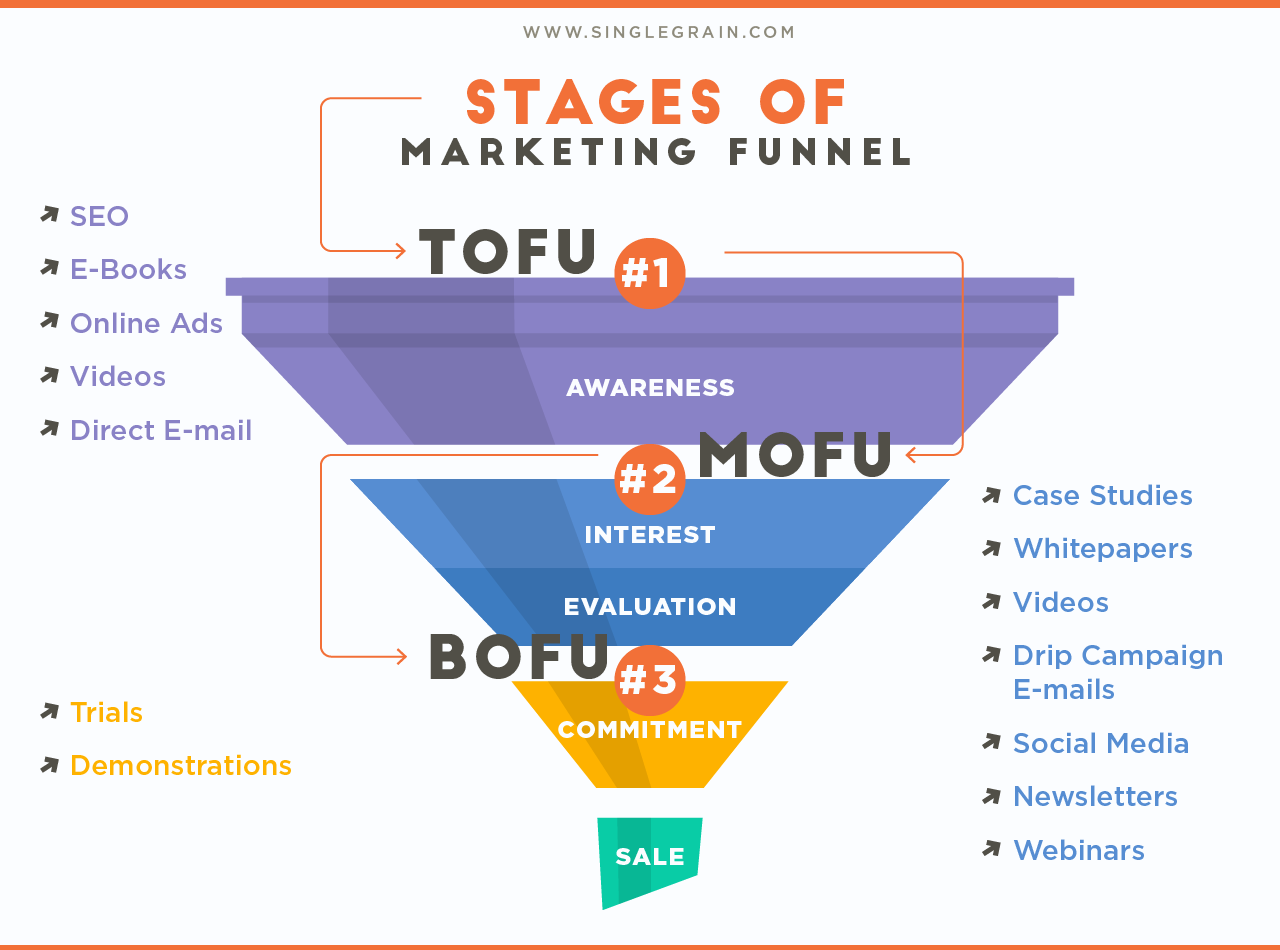
B) What Pain Point Does the Audience Have That Your Product Solves?
I find that, too often, companies write about their customers’ pain points, but they aren’t necessarily the pain points that your company’s product solves. So while a portion of the readers may have an additional pain point that your product does solve, it’s a very inefficient way to use content marketing to get customers.
It’s similar to a blueberry farmer selling blueberries to anyone who wants fruit rather than only selling to people who want blueberries. Sure, a percentage of the people who want fruit will probably also purchase, but in a world with limited resources, you’re better off just selling to people who specifically want blueberries.
To give you a B2B example, let’s say that you are selling sales managers an email finder product (maybe similar to Hunter.io):
- In this case, writing about “how to organize a sales team” will probably bring in the right audience (sales managers), but it isn’t the right keyword because your product doesn’t help them solve their sales team organization problems.
- A better keyword would be something like “how to improve sales rep efficiency.” In this case, an effective email finder does improve a sales rep’s efficiency.
Therefore, you should drive as much traffic as possible to “how to improve sales rep efficiency,” and you should care about where that post ranks in the SERPs.
To track your traffic and rankings, you can use a tool like Ahrefs or even a free one like Google Search Console.
Dive Deeper:
* What’s the Right Content for Each Stage of the Marketing Funnel?
* How to Create a Powerful Marketing Funnel Step-by-Step
* The Ultimate Guide to Developing Buyer Personas (with Templates!)
Final Thoughts on Content Marketing Metrics
Don’t measure content marketing metrics just for the sake of measuring metrics. If you’re tracking over twenty different metrics, you’re probably not using the data efficiently enough to improve your processes.
Therefore, think of your metrics as nothing more than signals to help you uncover patterns that lead to conversions. Once you’ve managed to achieve real business results, you’ll never have to worry about creating excellent reports with perfect metrics to keep your boss or client happy.
Hopefully you learned how to pick the right metrics to track your content marketing! But if you just want an expert content marketing agency to do it for you, click here.
